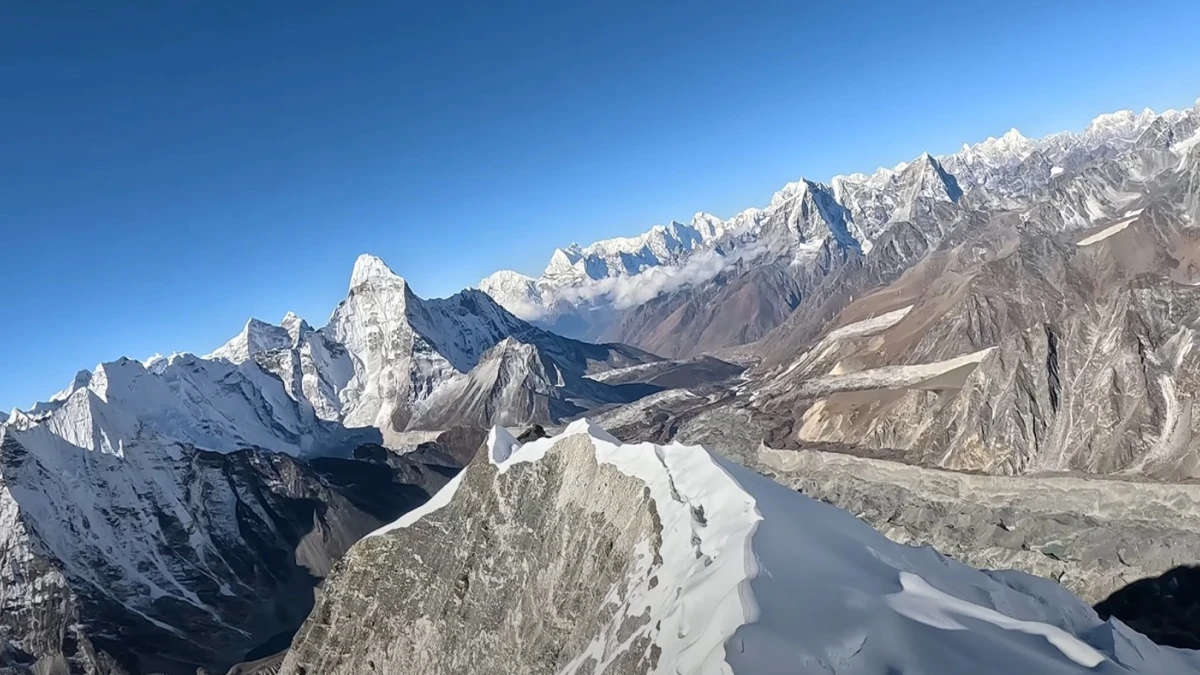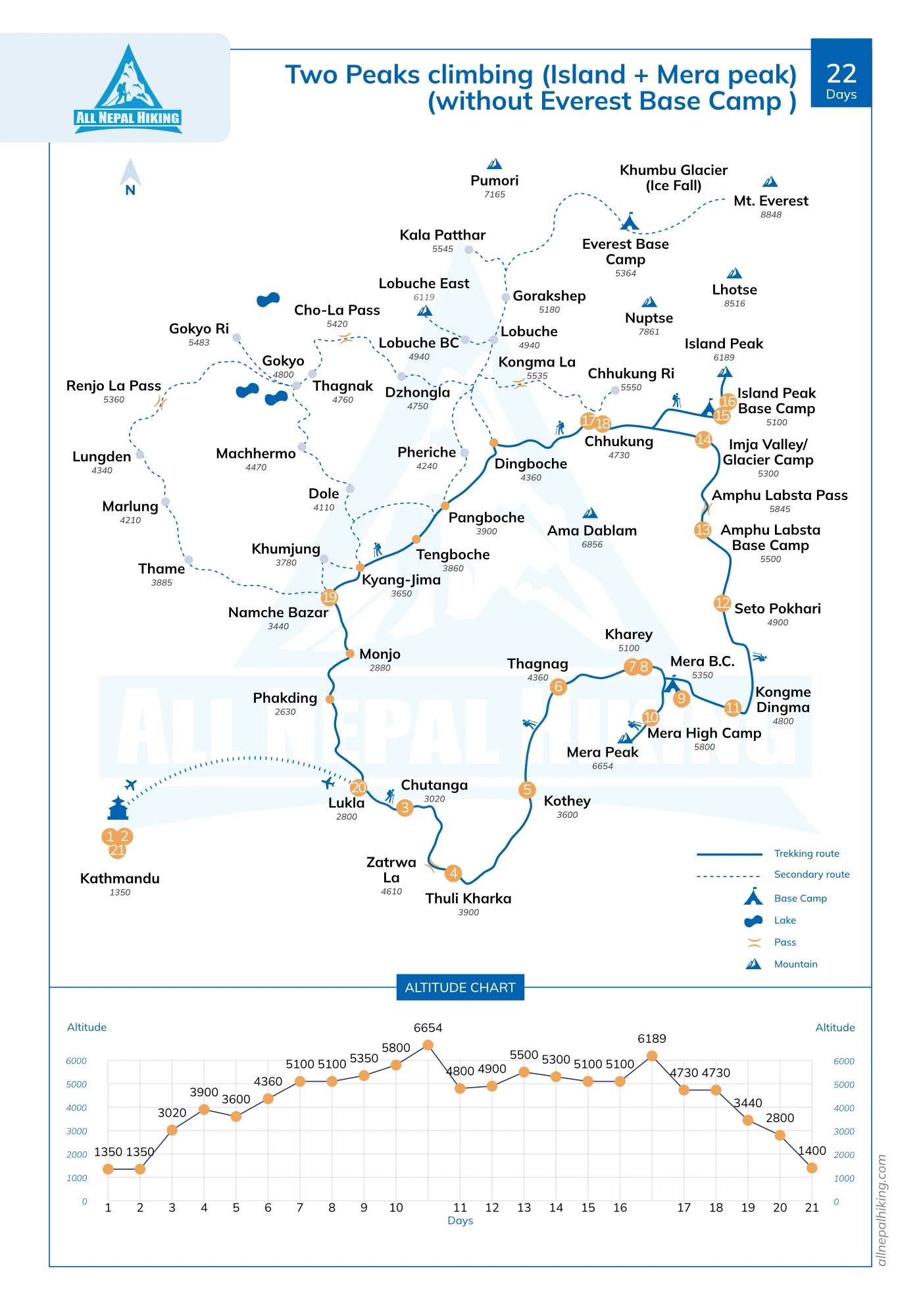Climbing Island Peak and Mera Peak without including the Everest Base Camp trek allows climbers to focus solely on the two peaks and their unique highlights. By focusing solely on climbing Island Peak and Mera Peak, climbers can dedicate their time and energy to these two extraordinary mountains. This allows for a more concentrated and immersive experience, enabling climbers to fully appreciate the unique highlights and challenges each peak offers. Additionally, excluding the Everest Base Camp trek allows for a more off-the-beaten-path adventure, with fewer crowds and a greater sense of remoteness in the Himalayas.
Two Peaks climbing (island + Mera peak) (without Everest Base Camp )
- Duration22 Days
- DestinationNepal
- Difficulty Level Hard
- Maximum Altitude 5800 m
- Activity Peak Climbing
- Group Size 1+
- Accommodation Hotel/Teahouse/Lodge
- Meals Breakfast, Lunch, Dinner
- Best Season March to May and September to December
- Island Peak:
- Spectacular Views: Island Peak offers stunning panoramic views of the surrounding peaks, including the iconic Lhotse and Ama Dablam. The vistas from the summit are breathtaking and provide a sense of awe-inspiring beauty.
- Technical Challenge: Climbing Island Peak requires technical skills such as using crampons, ropes, and ice axes. The ascent involves crossing glaciated terrain and navigating steep ice slopes, providing a thrilling challenge for experienced climbers.
- Summit Achievement: Reaching the summit of Island Peak is a significant accomplishment. Standing at an elevation of 6,189 meters (20,305 feet), climbers can celebrate their success and enjoy the rewarding feeling of conquering a Himalayan peak.
2. Mera Peak:
- Highest Trekking Peak: Mera Peak holds the distinction of being the highest trekking peak in Nepal. At an impressive height of 6,476 meters (21,247 feet), standing atop Mera Peak offers a sense of achievement and allows climbers to soak in the surrounding mountain vistas.
- Stunning Landscapes: The climb to Mera Peak takes you through diverse landscapes, including lush forests, high passes, and picturesque valleys. The journey showcases the natural beauty of the region and provides a captivating experience for climbers.
- Panoramic Himalayan Views: From the summit of Mera Peak, climbers are rewarded with breathtaking views of some of the world's highest peaks, including Everest, Makalu, Cho Oyu, and Kanchenjunga. The panoramic vistas are awe-inspiring and create lasting memories.
1. Arrival & Departure by Private Car
2. Accommodation in a standard hotel in Kathmandu for 4 nights on sharing basis
3. All meals are prepared by our experienced cook during the climb
4. All accommodation and food in lodges before base camp
5. All Domestic Flight tickets with Airport Tax
6. All camping equipment and gear, including two-person tent, dining tent, toilet tent, porter tent, and Kitchen tent
7. All camping equipment, including kitchen equipment, tables, chairs/stools, etc
8. Porters/pack animals to carry all personal gear and group equipment
9. Experienced Guide/Escort
10. Private Transport from Kathmandu to/ from trek starting and ending points
11. Basic first Aid kit
12. Trekking maps
13. Trekking permit & fees, National Park entry fees, Conservation fees
14. Insurance for all staff
15. High altitudes chamber bags (PAC) for very high altitudes
1. International Air-fare
2. All bar bills during the trek (soft drinks, hot drinks & alcoholic drinks)
4. Items of personal drinks, Dessert, and main meals in cities
5. Your Travel Insurance
7. Personal trekking equipment
8. Nepal entry visa: you can obtain a visa easily upon your arrival at Tribhuvan International Airport in Kathmandu.
9. Tips for trekking staff and driver (Tipping is respected but it is not obligatory)
| Trip Date | Price | Status | ||
|---|---|---|---|---|
| Start DateStartsFeb 12, 2026 | End DateEndsMar 05, 2026 | PriceUS$3499 | StatusAvailable |
Q1. What is peak climbing in Nepal?
Peak climbing in Nepal refers to the activity of climbing mountains or peaks that are below 7,000 meters (22,965 feet) in elevation. It involves a combination of trekking and mountaineering skills, and it is a popular adventure activity for those seeking to experience the thrill of climbing in the Himalayas.
Q2. What are some popular peaks for climbing in Nepal?
Nepal offers numerous peaks for climbing, ranging from relatively easier ones to more challenging summits. Some popular peaks for climbing in Nepal include Island Peak Climbing with E.B.C Trekking - 19 Days, Mera Peak Climbing, Lobuche Peak Climbing, Pisang Peak Climbing - 19 Days, Yala Peak Climbing - 15 Days, Singhu Chuli or Flute Peak Climbing - 23 Days and Tent Peak Climbing in Nepal - 19 Days, among others.
Q3. Do I need climbing experience to go peak climbing in Nepal?
While having prior climbing experience is beneficial, it is not always a requirement for peak climbing in Nepal. There are peaks suitable for both novice climbers and those with previous mountaineering experience. However, it is essential to have a good level of physical fitness and be prepared for the challenges of high-altitude trekking and basic mountaineering techniques.
Q4. Do I need a climbing permit for peak climbing in Nepal?
Yes, a climbing permit is required for peak climbing in Nepal. The permit is issued by the Nepal Mountaineering Association (NMA) or the Ministry of Tourism. The permit fee varies depending on the peak's elevation and location. Additionally, you may need to obtain other permits, such as trekking permits and national park permits, depending on the specific region you plan to visit.
Q5. Do I need a guide for peak climbing in Nepal?
It is highly recommended to hire an experienced guide or join a reputable trekking agency for peak climbing in Nepal. A guide can provide valuable assistance in navigating the terrain, ensuring your safety, and handling any emergencies that may arise. They also have extensive knowledge of the area, local culture, and can enhance your overall trekking experience.
Q6. What kind of equipment is required for peak climbing in Nepal?
Peak climbing in Nepal requires specialized equipment, including mountaineering boots, crampons, ice axes, harnesses, ropes, helmets, and appropriate clothing layers to withstand the harsh mountain conditions. It is advisable to bring your personal gear, although some items can be rented in Kathmandu or from trekking agencies.
Q7. Is altitude sickness a concern during peak climbing in Nepal?
Yes, altitude sickness is a significant concern during peak climbing in Nepal, as many peaks exceed 5,000 meters (16,404 feet) in elevation. Proper acclimatization is crucial to prevent altitude-related illnesses. Climbers are advised to ascend gradually, stay hydrated, and follow a well-planned itinerary that includes rest days for acclimatization. It is essential to be aware of the symptoms of altitude sickness and descend if they become severe.
Q8. How physically demanding is peak climbing in Nepal?
Peak climbing in Nepal can be physically demanding, especially at high altitudes. It requires a good level of cardiovascular fitness, endurance, and strength. Prior training and preparation, including regular exercise, hiking, and cardiovascular activities, can significantly help in improving your physical fitness and endurance for the climb.
Q9. Are there any age restrictions for peak climbing in Nepal?
There are no specific age restrictions for peak climbing in Nepal. However, climbers should be in good health, physically fit, and capable of enduring the physical demands and challenges of high-altitude trekking and basic mountaineering techniques. It is advisable to consult with your physician before undertaking any strenuous activity at high altitudes, especially if you have any pre-existing medical conditions.
Q10. What is the cost of peak climbing in Nepal?
The cost of peak climbing in Nepal can vary depending on several factors, such as the peak you choose to climb, the duration of the climb, the services provided by the trekking agency, and the number of climbers in the group. On average, the cost can range from a few thousand dollars to several thousand dollars per person.
Q11. Do I need travel insurance for peak climbing in Nepal?
Yes, it is highly recommended to have travel insurance that covers peak climbing activities in Nepal. The insurance should include coverage for emergency medical evacuation, trip cancellation or interruption, and medical expenses. Make sure to carefully review the terms and conditions of your insurance policy to ensure it covers all the necessary aspects of your trip.
Q12. How long does it take to climb a peak in Nepal?
The duration of peak climbing in Nepal varies depending on the peak's elevation, technical difficulty, and the chosen route. It can range from a few days for relatively easier peaks to several weeks for more challenging climbs. Most peak climbing expeditions in Nepal take around 2-3 weeks, including trekking to and from the base camp and the actual climb.
Q13. Can I climb a peak in Nepal without a guide?
While it is possible to climb a peak in Nepal without a guide, it is highly recommended to hire an experienced guide or join a reputable trekking agency. The guidance of a knowledgeable guide can significantly enhance your safety, provide assistance in navigating the route, and handle any emergencies that may arise during the climb.
Q14. Is peak climbing in Nepal dangerous?
Peak climbing in Nepal involves inherent risks and challenges, including high altitude, extreme weather conditions, and technical difficulties. However, with proper planning, experienced guides, and adherence to safety protocols, the risks can be minimized. It is important to have a good level of physical fitness, undergo proper acclimatization, and follow the guidance of experienced professionals to ensure a safe climbing experience.
Q15. Can I rent climbing equipment in Nepal?
Yes, it is possible to rent climbing equipment in Nepal. The city of Kathmandu has several shops that offer gear rental services for climbing and trekking activities. However, it is recommended to bring your personal gear, especially items such as mountaineering boots, crampons, and ice axes, to ensure proper fit and familiarity with your equipment.
Q16. Can I combine peak climbing with other treks in Nepal?
Yes, it is common to combine peak climbing with other treks in Nepal. Many peak climbing routes pass through popular trekking trails, allowing climbers to experience the beauty of the Himalayas while reaching their climbing objectives. Popular trekking routes like the Everest Base Camp trek and the Annapurna Circuit can be combined with peak climbing expeditions in their respective regions.





 based on 1 review
based on 1 review